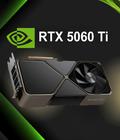Most critics disliked the Nvidia GeForce RTX 4060 Ti. The performance of the card fluctuated greatly when compared to the previous generation 3060 and 3070 cards, but it came in at a much higher price. To add to the confusion, there were two variants that differed only in VRAM capacity but had a $100 gulf between them. If you look at the latest Steam Hardware Survey, lots of people ended up buying the card, as it is the second-highest card from that generation on the list, behind the original RTX 4060. The release of the RTX 5060 Ti was inevitable, but many people did not expect the card to come out so quickly after the rest of the higher-class lineup. Then again, this is such an unusual time for Nvidia, as barely anything in the consumer sector has gone its way over the past few months.
As stated in previous reviews, Nvidia's two big features for this generation of cards are DLSS4 and multi-frame generation. For the former, its status hasn't changed. The picture of the game being upscaled with this method looks great, and while there are still a few areas where some shimmer and blur are present, you'll really need to zoom in on a few areas to notice it. For the latter, the technology doesn't work as well as expected on this class of card. The numbers may go up when counting frames, but there are some odd vibrations if the base frame rate is low. Worse is the fact that the game's responsiveness is hampered greatly, even if you're using a gamepad to mitigate that. An example we ran into is with Monster Hunter Wilds at 4K, which had its frame rate doubled from 30fps to 60fps with frame generation on, but navigation in the menus felt sluggish enough that the game felt terrible to play. Until Nvidia Reflex 2 finally arrives, frame generation of any type on a card like this isn't viable.
Compared to the 5070, the 5060 Ti has lower specs in most areas: 24 TFLOPS of AI Shader Cores instead of 31, 4608 CUDA cores as opposed to 6144, 759 Tensor Cores instead of 988, 72 TFLOPS of Ray Tracing Cores instead of 94, and a 128-bit Memory Interface instead of a 192-bit version. However, the Base Clock of 2.4GHz and the Boost Clock of 2.57GHz are much higher than the 5070's 2.16MHz Base Clock and 2.51MHz Boost Clock. This isn't a straight all-around downgrade like one would expect when going down the different video card tiers, and the same thing occurred between last generation's 4070 and 4060 Ti.
The spec that will catch people's attention is that the 5060 Ti comes in two variants, just like the 4060 Ti did, but both versions will release simultaneously instead of a month or two apart. At launch, you'll see a 16GB GDDR7 version and an 8GB GDDR7 version available for purchase, with no other spec differences between them. The presence of a 16GB variant is welcome but also puzzling, as it brings into question why the 5070 didn't also come with 16GB of VRAM instead of 12GB; the extra 4GB of VRAM would've given the 5070 some breathing room now that we're seeing some newer, big AAA titles encounter issues while running on 8GB of VRAM. It also calls into question why an 8GB version of the 5060 Ti needs to exist, especially since Nvidia has stated that there would be more 16GB versions of the card in the market compared to the 8GB variants. This isn't an ideal setup, especially since the two variants with the same name can lead to some regretful purchases for those unaware of the important spec difference.
There is one major difference between the launches of the 5060 Ti and the 4060 Ti: the MSRP. Even though it is the newer card, the 5060 Ti is aiming for a $379 price tag for the 8GB version instead of the $399 price the 4060 Ti launched with. Instead of launching at $100 more for the 16GB version of the 4060 Ti, the 5060 Ti 16GB variant is launching at only $50 more for a MSRP of $429. The lower MSRPs are welcome, and it's a sort of vindication for everyone calling out the big price difference in last generation's cards.
Then again, this is MSRP we're talking about, and if this generation's launch has proven anything, it is that MSRP holds no meaning. There is no Founders Edition version of this card, and while there will be third-party cards that try to aim for MSRP, that isn't so likely in the current market. Overall, card scarcity is still a factor, as almost all of the new 40-series cards are gone, and stock of the 50-series cards hasn't been replenished yet. Factor in scalping and variable tariffs, and the fact that even AMD cards are in low supply, and you have a situation ripe for price hikes. There's no way this card will be priced lower than $500, if we're lucky.
As stated earlier, with no Founders Edition of the card being made, Nvidia had sent us the PNY stock 16GB version of the card for review, and it does everything it can to emphasize its relatively budget nature. This is a small two-slot card with a standard two-fan setup. The shroud is all plastic, while the backplate is metal that feels rather thin. There are no RGB lights, but there is branding for the card in big, white letters on both the side and on the backplate. It's less of a stealthy card, despite the designation on the box that only referenced the lack of audible fan noise — unless you're really pushing the card. The power connector is unusual in that it is located close to the mounting bracket instead of away from it, but people will appreciate that this card uses one standard 8-pin PCI-E connector instead of the infamous 16-pin PCI-E connector, almost ensuring that there's little to no chance of this card succumbing to the connector melting, which occurred in other 50-series cards.
The PC we're using for these tests is a Ryzen 7 7700X equipped with 32GB of G.Skill Flare X5 Series DDR5-6000 RAM in a dual channel configuration. The motherboard is the MSI B650-P Pro. We're using Windows 11 version 24H2, and the Nvidia press driver is version 575.94. Despite showing some 4K data in some of the graphics, the majority of the benchmarks were taken at a 1440p resolution, since 4K proved way too taxing for some of the heavier games in the list, and 1080p was already more than viable for the 4060 Ti. All of the graphical settings were at their maximum level, and DLSS was set to Quality. As usual, we'd highly recommend seeking out other reviews of the card from other outlets to get a fuller picture of this card's capabilities across a wide range of games.
3DMark
The 3DMark suite of synthetic benchmarks shows off some expected results as far as scores go between the cards. In Fire Strike, the 5060 Ti scores 34585, which is roughly 7000 points lower than what the 5070 got. The gulf is roughly the same in Fire Strike Extreme, while the difference in Fire Strike Ultra is roughly 4000 points between the two cards. In Time Spy, the 5060 Ti scores 9671, roughly 400 points less than the 5070's score of 13942, while the score difference in Time Spy Extreme is around 2000 points. The point differences in the various ray tracing tests (Port Royale, Speed Way, and Steel Nomad) are smaller but still significant enough that you'll notice the 5060 Ti struggling in a few scenes.
Red Dead Redemption II
Red Dead Redemption II's age hides the fact that Rockstar's engine can be heavy when it wants to be. At 1440p, the 5060 Ti barely makes the playable mark with a 63fps average, while DLSS bumps it to a 71fps average. At 4K, you'll really want to drop settings because you'll get a 43fps average otherwise, and DLSS only bumps things to 52fps. While that isn't bad compared to the 5070 at 4K, the pricier card certainly outclasses the 5060 Ti with a much higher frame rate at 1440p.
Horizon Zero Dawn Remastered
At 1440p, Horizon Zero Dawn Remastered sees the 5060 Ti score a 92fps average, which is low compared to the 107fps scored by the 5070 but still impressive. With those results, DLSS isn't necessary, but for those who want to use it anyway, the 5060 Ti will net a 116fps average and a 152fps average with frame generation, which for some reason, beats the numbers we got from the RTX 5070.
Final Fantasy XIV Online: Dawntrail
The benchmark goes through parts of the MMO in a cinematic fashion, and the only knock against it is the fact that you can't turn off either FSR or DLSS. Otherwise, the results indicate that certain games can showcase the 5060 Ti in a good light. At 1440p, the card scores a 107fps average with a 67fps low, which isn't bad when pitted up against the 5070 with a 139fps average and a 72fps low. At 4K, the 5060 Ti holds steady with a 70fps average and a 49fps low, which is still pretty impressive when compared to the 5070 scoring a 78fps average and a 56fps low at this resolution.
Avatar: Frontiers of Pandora
Avatar: Frontiers of Pandora isn't the newest iteration of the Snowdrop engine, but it is still valuable as a title that always runs ray tracing and only relies on FSR for frame generation. It is also a weird title in that it shows some degradation when using DLSS. At 1440p, the 5060 Ti scores a 70fps average and a 55fps low, which almost matches the performance of the game on the 5070. The story is the same when you turn on DLSS or FSR3 with frame generation, which makes this title a big anomaly among the other games tested for this review.
Black Myth: Wukong
Even though Black Myth: Wukongwas built using an Nvidia-friendly version of Unreal Engine 5, don't expect this card to go easy with lower-class Nvidia cards at native resolution for at least another generation or two. A native resolution scale at 1440p will only net a 32fps average, and unless you want to go with frame generation, you'll need to lower the DLSS resolution scaling or drop loads of settings to get close to a 60fps average. This is all without ray tracing, as adding in that technology gets you such a low frame rate that you'll definitely need to go lower than 75% resolution scaling even with frame generation on to reach a playable frame rate.
Cyberpunk 2077
There's Cyberpunk 2077, which is always a good game to use for benchmarks, as it seems to have almost every graphical enhancement. With the game barely functional at 4K, testing was restricted to 1440p. With no ray tracing at all, the 5060 Ti squeaks by with a 55fps average and a 48fps low, good enough that turning down a few things just one step will easily get you over that 60fps mark. Add DLSS to the mix, and you'll get a 100fps average using the CNN version and only drop to a 93fps average when using the Transformer version. Using frame generation gets you way over 100fps on average, but you'll be fine without it. Turn on any form of ray tracing, and the game needs DLSS to go just below 60fps, while path tracing proves to be too heavy for this card unless you try to make up the difference with much lower settings or frame generation, which is not really recommended with the base frame rate being so low.
Monster Hunter Wilds
Finally, Monster Hunter Wilds might seem like it'll push video cards considering that it was recently released, but the 5060 Ti actually handles it quite well at 1440p. The card scores an average of 56fps at this resolution, and the drop with ray tracing isn't so drastic as the 5060 Ti gets a 51fps average. DLSS brings the frame rate to the mid to high 60s with ray tracing on and off, respectively, while frame generation nets the card a 91fps average with ray tracing off and 86fps with ray tracing on.
It's tough to deliver a verdict on the GeForce RTX 5060 Ti beyond the fact that you'd want the 16GB version over the 8GB version, no matter what. On paper, it seems like a nice alternative for those who want to hit 1440p gaming and do so with only a few sacrifices. The 16GB VRAM availability makes for a tempting way to future-proof yourself against some big AAA games, and the absence of a 16-pin PCI-E 5.0 connector means that it solves one issue from Nvidia's current lineup, provided other third-party card manufacturers follow suit. Once reality sinks in, the pricing and Nvidia's other documented issues with higher cards in the stack and other outside forces may make this another card that few people will try out, even long after the RTX 5060 arrives next month.
Score: 7.0/10
More articles about NVIDIA Geforce RTX 5060 Ti











 GeForce RTX 5060 family of GPUs deliver neural rendering and NVIDIA Blackwell architecture innovations for every gamer featuring feature NVIDIA DLSS 4, full ray tracing, neural rendering and NVIDIA Reflex technologies for exceptional performance and image quality.
GeForce RTX 5060 family of GPUs deliver neural rendering and NVIDIA Blackwell architecture innovations for every gamer featuring feature NVIDIA DLSS 4, full ray tracing, neural rendering and NVIDIA Reflex technologies for exceptional performance and image quality.








